8 types of lizards found across India and how they survive
19
8 types of lizards found across India
Lizards are often seen on walls, in gardens, or resting on sunlit rocks along trails. They usually go unnoticed, blending quietly into everyday surroundings. Found across India, these reptiles have adapted in smart and subtle ways. Some shift their colour, others glide between trees, and a few display bright throat flaps during mating. From urban rooftops to remote forests, each species has its own way of surviving– often more fascinating than expected.
.
29
Agamas
Ever spotted a lizard with bright orange or electric blue skin, sitting like royalty on a rock? That’s likely an agama. The males get especially colourful during mating season– not just for style, but to send a message: either “pick me” or “back off.” You’ll mostly find them sunbathing on stones, especially in rocky areas, doing quick head nods or darting away before you even blink.
Garden Lizards
These are the ones we see every day– on garden walls, fences, and rooftops. They’re not dramatic like agamas, but they’re fast and smart. Garden lizards can adjust their colours a bit, usually to match their background and stay hidden. You’ll often find them stretched out in the sun or keeping still as they wait for a bug to pass by. In their own quiet way, they help keep insect numbers under control.
Chameleons
Chameleons move with a kind of careful confidence, usually hidden among leaves or branches. Most people know them for changing colour– but it’s not always about camouflage. Sometimes it’s mood, and sometimes it’s temperature.
Their eyes are the real surprise. Each one moves on its own, scanning the surroundings without needing to turn their head. And when they spot an insect? That long, sticky tongue shoots out faster than you’d expect from such a slow-moving animal.
59
Fan-Throated Lizards
They may be tiny, but fan-throated lizards know how to get attention. Males have this flap of skin under their neck– brightly coloured like a signal flag– which they flash during courtship or when marking territory. You’ll find them in dry, open spaces with grass or shrubs. They move fast, disappear faster, and know exactly when to stay still.
Flying Lizards
Flying lizards don’t actually fly. But what they do is close enough. With flaps of skin along their sides and between their ribs, they can glide from one tree to another like little dragon gliders. They stay mostly up high, out of reach. These lizards are well-built for tree life– flat bodies, strong legs, and the kind of balance that keeps them stable even on thin branches. They’re rarely seen on the ground.
79
Geckos
The soft clicking sound of a house gecko is a familiar part of nights in many Indian homes. These small lizards are often seen climbing walls or resting on ceilings. Their toes have tiny hair-like grips that help them stick to smooth surfaces with ease. They usually come out after dark, looking for insects near lights or leftover food. Quiet and harmless, they often go unnoticed– but they actually help by keeping pests away.
Monitor Lizards
Monitor lizards are the heavyweights of the lizard world– some growing as long as a person. You’ll find them near rivers, forests, and even farms. Despite their size and sharp claws, they usually stay clear of people.
They eat just about anything– bugs, eggs, birds, even smaller animals. What sets them apart is their intelligence. They’re good problem solvers and have been seen using their strong limbs to dig or climb when hunting. And yes, they’re excellent swimmers too.
Rock Lizards
You’ll spot these in hill regions or rocky outcrops– if you’re lucky. Their rough skin and dull colours let them disappear into the stone around them. They’re small, tough, and excellent at squeezing into cracks when they feel unsafe.
During the day, they come out to warm up and look for insects. Their bodies are made for climbing and hiding in tough terrain– simple survival, done right.
India is home to a diverse range of lizard species, each adapted to various habitats and ecological niches. Here are eight common types of lizards found across India along with how they survive in their environments:
Common Garden Lizard (Calotes versicolor)Habitat: Gardens, forests, urban areas Survival: They are arboreal and terrestrial, feeding on insects and small invertebrates. Their ability to change color helps in camouflage and temperature regulation.
Indian Rock Agama (Psammophilus dorsalis)Habitat: Rocky outcrops, dry Forest survival: They bask on rocks to regulate body temperature and are fast runners to escape predators. Their diet consists mainly of insects.Fan-throated Lizard (Sitana ponticeriana)
Habitat: Grasslands and scrublands Survival: Males display a colorful fan-like throat flap to attract mates and intimidate rivals. They feed on ants and small insects, relying on speed for survival.
Flying Lizard or Draco (Draco dussumieri)Habitat: Forests, especially Tropical survival: They glide between trees using wing-like lateral skin flaps, escaping predators and moving to find food (mainly ants and termites).
Monitor Lizard (Varanus species, e.g., Varanus bengalensis)Habitat: Forests, wetlands, agricultural Lands survival: Large and powerful, they are opportunistic feeders eating insects, small mammals, eggs, and carrion. They burrow and swim well to evade threats.Skinks (Family Scincidae, e.g., Mabuya species)
Habitat: Leaf litter, under stones, forest Floors survival: They have smooth, shiny scales and quick reflexes. Skinks feed on insects and small invertebrates, hiding under debris to avoid predators.Gecko (Hemidactylus species, e.g., House Gecko)
Habitat: Human habitations, rocky areas, Forest survival: Nocturnal and insectivorous, they have adhesive toe pads allowing them to climb walls and ceilings, avoiding many predators. Their vocalizations help in communication.Chameleon (Chamaeleo zeylanicus)
Habitat: Forested areas, Shrubs survival: Known for their color-changing ability for camouflage and communication. They have a projectile tongue to catch insects and well-developed eyesight to spot prey and predators.These lizards survive through various adaptations such as camouflage, speed, climbing ability, dietary flexibility, and behavioral traits like basking or gliding. Their survival strategies are closely linked to their habitat and ecological role.
Lizards are often seen on walls, in gardens, or resting on sunlit rocks along trails. They usually go unnoticed, blending quietly into everyday surroundings. Found across India, these reptiles have adapted in smart and subtle ways. Some shift their colour, others glide between trees, and a few display bright throat flaps during mating. From urban rooftops to remote forests, each species has its own way of surviving– often more fascinating than expected.
2/9
Agamas
Ever spotted a lizard with bright orange or electric blue skin, sitting like royalty on a rock? That’s likely an agama. The males get especially colourful during mating season– not just for style, but to send a message: either “pick me” or “back off.” You’ll mostly find them sunbathing on stones, especially in rocky areas, doing quick head nods or darting away before you even blink.

3/9
Garden Lizards
These are the ones we see every day– on garden walls, fences, and rooftops. They’re not dramatic like agamas, but they’re fast and smart. Garden lizards can adjust their colours a bit, usually to match their background and stay hidden. You’ll often find them stretched out in the sun or keeping still as they wait for a bug to pass by. In their own quiet way, they help keep insect numbers under control.
Chameleons
Chameleons move with a kind of careful confidence, usually hidden among leaves or branches. Most people know them for changing colour– but it’s not always about camouflage. Sometimes it’s mood, and sometimes it’s temperature.
Their eyes are the real surprise. Each one moves on its own, scanning the surroundings without needing to turn their head. And when they spot an insect? That long, sticky tongue shoots out faster than you’d expect from such a slow-moving animal.
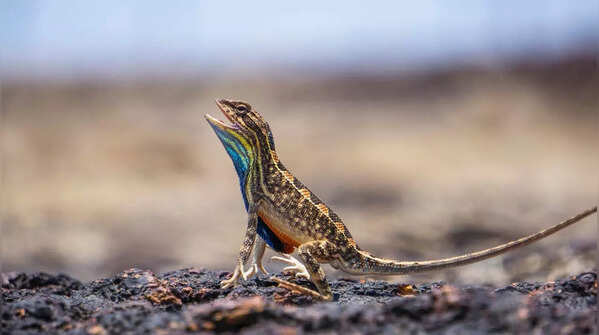
5/9
Fan-Throated Lizards
They may be tiny, but fan-throated lizards know how to get attention. Males have this flap of skin under their neck– brightly coloured like a signal flag– which they flash during courtship or when marking territory. You’ll find them in dry, open spaces with grass or shrubs. They move fast, disappear faster, and know exactly when to stay still.
6/9
Flying Lizards
Flying lizards don’t actually fly. But what they do is close enough. With flaps of skin along their sides and between their ribs, they can glide from one tree to another like little dragon gliders. They stay mostly up high, out of reach. These lizards are well-built for tree life– flat bodies, strong legs, and the kind of balance that keeps them stable even on thin branches. They’re rarely seen on the ground.
types of lizards found across India and how they survive
Trending
8 types of lizards found across India and how they survive
8 types of lizards found across India
Lizards are often seen on walls, in gardens, or resting on sunlit rocks along trails. They usually go unnoticed, blending quietly into everyday surroundings. Found across India, these reptiles have adapted in smart and subtle ways. Some shift their colour, others glide between trees, and a few display bright throat flaps during mating. From urban rooftops to remote forests, each species has its own way of surviving– often more fascinating than expected.

2/9
Agamas
Ever spotted a lizard with bright orange or electric blue skin, sitting like royalty on a rock? That’s likely an agama. The males get especially colourful during mating season– not just for style, but to send a message: either “pick me” or “back off.” You’ll mostly find them sunbathing on stones, especially in rocky areas, doing quick head nods or darting away before you even blink.
3/9
Garden Lizards
These are the ones we see every day– on garden walls, fences, and rooftops. They’re not dramatic like agamas, but they’re fast and smart. Garden lizards can adjust their colours a bit, usually to match their background and stay hidden. You’ll often find them stretched out in the sun or keeping still as they wait for a bug to pass by. In their own quiet way, they help keep insect numbers under control.
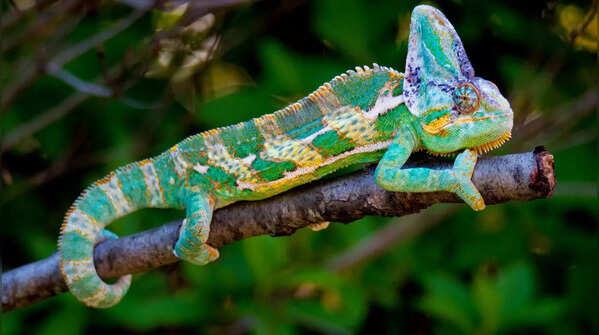
4/9
Chameleons
Chameleons move with a kind of careful confidence, usually hidden among leaves or branches. Most people know them for changing colour– but it’s not always about camouflage. Sometimes it’s mood, and sometimes it’s temperature.
Their eyes are the real surprise. Each one moves on its own, scanning the surroundings without needing to turn their head. And when they spot an insect? That long, sticky tongue shoots out faster than you’d expect from such a slow-moving animal.

5/9
Fan-Throated Lizards
They may be tiny, but fan-throated lizards know how to get attention. Males have this flap of skin under their neck– brightly coloured like a signal flag– which they flash during courtship or when marking territory. You’ll find them in dry, open spaces with grass or shrubs. They move fast, disappear faster, and know exactly when to stay still.
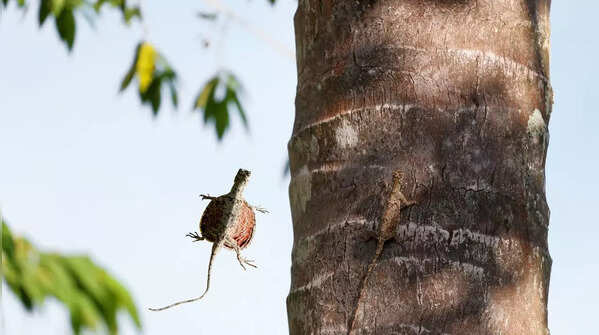
6/9
Flying Lizards
Flying lizards don’t actually fly. But what they do is close enough. With flaps of skin along their sides and between their ribs, they can glide from one tree to another like little dragon gliders. They stay mostly up high, out of reach. These lizards are well-built for tree life– flat bodies, strong legs, and the kind of balance that keeps them stable even on thin branches. They’re rarely seen on the ground.
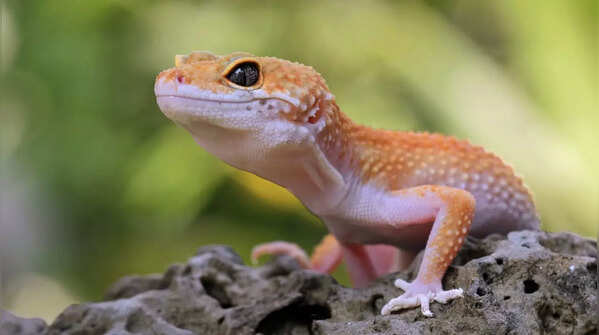
7/9
Geckos
The soft clicking sound of a house gecko is a familiar part of nights in many Indian homes. These small lizards are often seen climbing walls or resting on ceilings. Their toes have tiny hair-like grips that help them stick to smooth surfaces with ease. They usually come out after dark, looking for insects near lights or leftover food. Quiet and harmless, they often go unnoticed– but they actually help by keeping pests away.
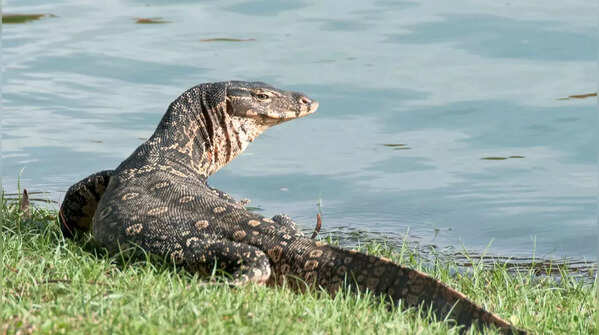
8/9
Monitor Lizards
Monitor lizards are the heavyweights of the lizard world– some growing as long as a person. You’ll find them near rivers, forests, and even farms. Despite their size and sharp claws, they usually stay clear of people.
They eat just about anything– bugs, eggs, birds, even smaller animals. What sets them apart is their intelligence. They’re good problem solvers and have been seen using their strong limbs to dig or climb when hunting. And yes, they’re excellent swimmers too.
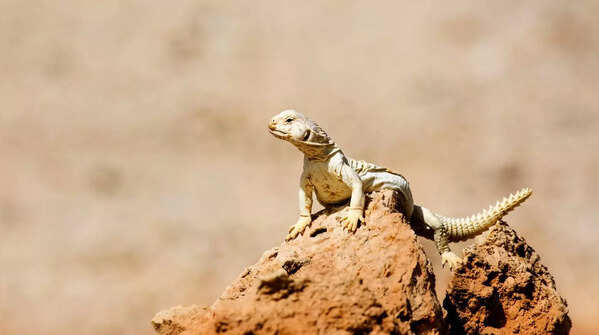
9/9
Rock Lizards
You’ll spot these in hill regions or rocky outcrops– if you’re lucky. Their rough skin and dull colours let them disappear into the stone around them. They’re small, tough, and excellent at squeezing into cracks when they feel unsafe.
During the day, they come out to warm up and look for insects. Their bodies are made for climbing and hiding in tough terrain– simple survival, done right.
